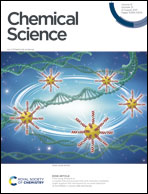|
Autores/as
Chen, Wei W. ; Pipaon Fernández, Nahiane; Díaz Baranda, Marta; Cunillera, Anton; Rodríguez, Laura G. ; Pipaon Fernández, Nahiane; Díaz Baranda, Marta; Cunillera, Anton; Rodríguez, Laura G. ; Shafir, Alexandr; Cuenca, Ana B. ; Shafir, Alexandr; Cuenca, Ana B.
|
Abstract
A stepwise build-up of multi-substituted Csp3 carbon centers is an attractive, conceptually simple, but often synthetically challenging type of disconnection. To this end, this report describes how gem-α,α-dimetalloid-substituted benzylic reagents bearing boron/silicon or boron/tin substituent sets are an excellent stepping stone towards diverse substitution patterns. These gem-dimetalloids were readily accessed, either by known carbenoid insertion into C–B bonds or by the newly developed scalable deprotonation/metallation approach. Highly chemoselective transformations of either the C–Si (or C–Sn) or the C–B bonds in the newly formed gem-Csp3 centers have been achieved through a set of approaches, with a particular focus on exploiting the synthetically versatile polarity reversal in organometalloids by λ3-aryliodanes. Of particular note is the metal-free arylation of the C–Si (or C–Sn) bonds in such gem-dimetalloids via the iodane-guided C–H coupling approach. DFT calculations show that this transfer of the (α-Bpin)benzyl group proceeds via unusual [5,5]-sigmatropic rearrangement and is driven by the high-energy iodine(III) center. As a complementary tool, the gem-dimetalloid C–B bond is shown to undergo a potent and chemoselective Suzuki–Miyaura arylation with diverse Ar–Cl, thanks to the development of the reactive gem-α,α-silyl/BF3K building blocks.
|

WoS
Scopus
Altmetrics
 
|
|
Publicación
Chemical Science, 21 August 2021, v.12, n.31, p. 10514–10521
|
